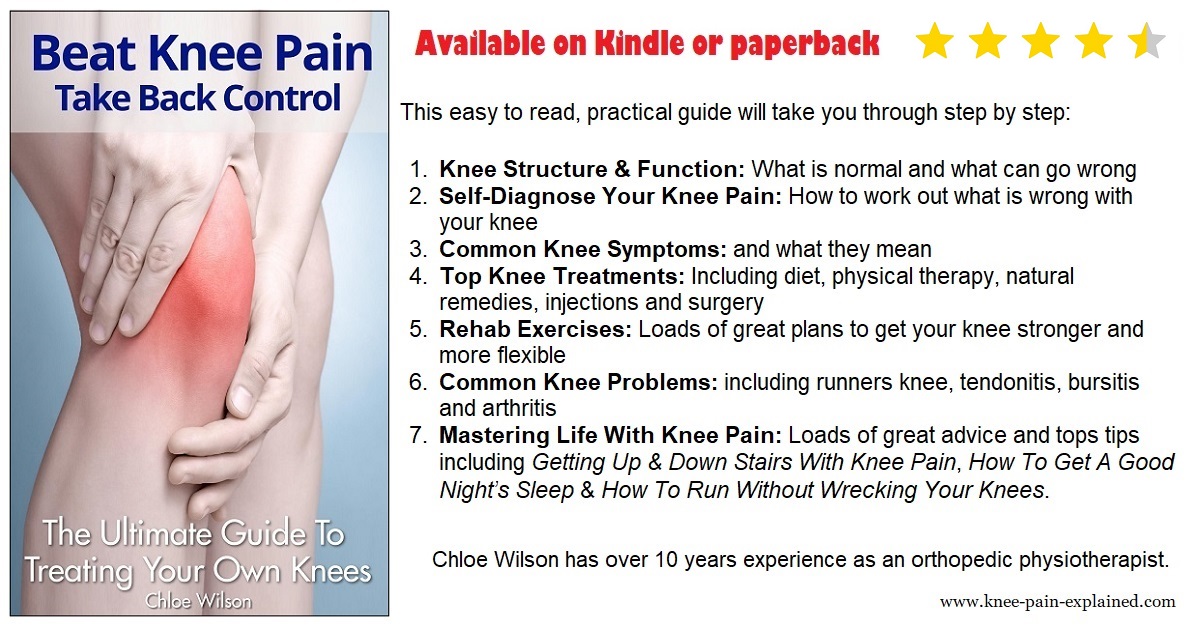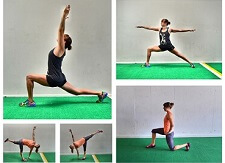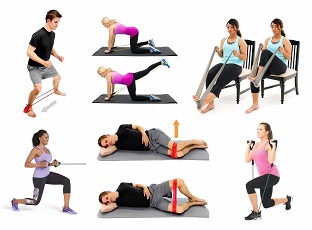- Home
- Knee Exercise Guide
- VMO Exercises
Vastus Medialis Exercises
Written By: Chloe Wilson, BSc(Hons) Physiotherapy
Reviewed by: KPE Medical Review Board
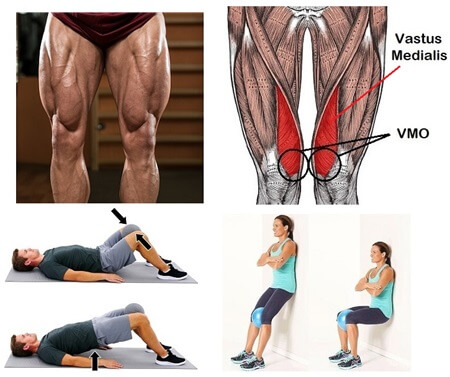
Vastus medialis exercises are a great way to improve knee stability and function, reduce knee pain and reduce the risk of cartilage injuries.
Most people who suffer from long term knee pain have a weak vastus medialis muscle.
This alters the way the knee moves, how the forces are directed through the knee and places excess strain on the inner knee.
The great news is that vastus medialis strengthening exercises can easily be done at home or in the gym without the need for specialist equipment.
Where Is The Vastus Medialis Muscle?
The vastus medialis muscle is the inner most of the four quadriceps muscles found on the front of the thigh.
The main bulk of vastus medialis is found just above the knee cap on the inner (medial) side of the knee.
If you clench your thigh muscles, vastus medialis forms a bulge on the inner thigh, often referred to as the tear drop muscle.
This part of the muscle is known as vastus medialis oblique, aka VMO or vastus medialis obliquus, as the muscle fibres here pass obliquely into the kneecap.
Vastus Medialis Function
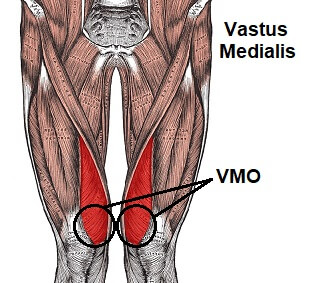
The vastus medialis muscle as a whole works with the other quadriceps muscles to straighten the knee and thus extend the leg.
Vastus medialis is particularly important in the final stages of knee extension where it helps with the locking mechanism of the knee joint.
The vastus medialis oblique (VMO) portion on the muscle has an extra function of helping to control how the kneecap moves and provides stability.
The shape of the knee means that naturally the kneecap would glide slightly over to the outer side of the knee when bending the leg. This would place excessive friction through the cartilage lining the back of the kneecap as well as increasing the risk of patella dislocation.
However, the positioning and direction of the VMO muscle fibres help to counteract this by drawing the kneecap inwards, or medially. This ensures that as the knee bends and straightens, the kneecap glides smoothly up and down the groove on the thigh bone so there is no friction on the back of the kneecap.
The main problems that develop in the vastus medialis oblique muscle are:
- Weakness: which can affect both instantaneous strength and endurance meaning the muscle tires faster than it should
- Mis-firing: there may be a delay in the activation of the VMO or it may switch off completely
People with a weak vastus medialis oblique muscle are more prone to:
- Patellofemoral Knee Pain
- Knee Instability
- Kneecap Dislocation
Most people suffering from anterior knee pain will benefit from doing vastus medialis exercises.
How To Do Vastus Medialis Exercises
Vastus medialis and vastus medialis oblique are part of the same muscle so you don’t need to do different exercises for each part. But, you do want to make sure that VMO is activating properly.
Clenching a squashy ball between your knees as you do vastus medialis exercises really helps to make sure the VMO is switching on. A foam ball is best but if you don’t have one, use a soccer ball, just make sure has a bit of give in it by letting some of the air out.
We’ll start by looking at how to activate vastus medialis oblique and then look at a whole range of vastus medialis exercises.
1. VMO Activation
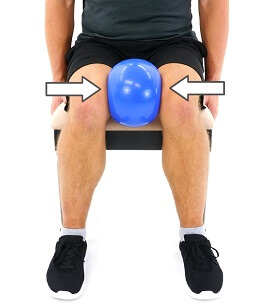
- Sit upright in a chair, with your knees bent, ball between your knees and your feet flat on the floor. Place your thumbs on the soft, squashy area on the inner side of the knee, just above your kneecaps and press down firmly
- Clench your glutes and gently squeeze the ball, making sure the movement comes from your knee rather than the inner thigh
- You should feel a tightening or swelling underneath your thumbs which shows you that you are activating vastus medialis and the VMO. That’s the area we want to make sure is working with all the exercises
- If you can't feel it, trying clenching your buttocks, clenching your knees and squashing the backs of your thighs down into the chair
Test both sides together, particularly if you have knee pain or swelling, as you may well notice a difference between sides.
2. Ball Clench Extensions
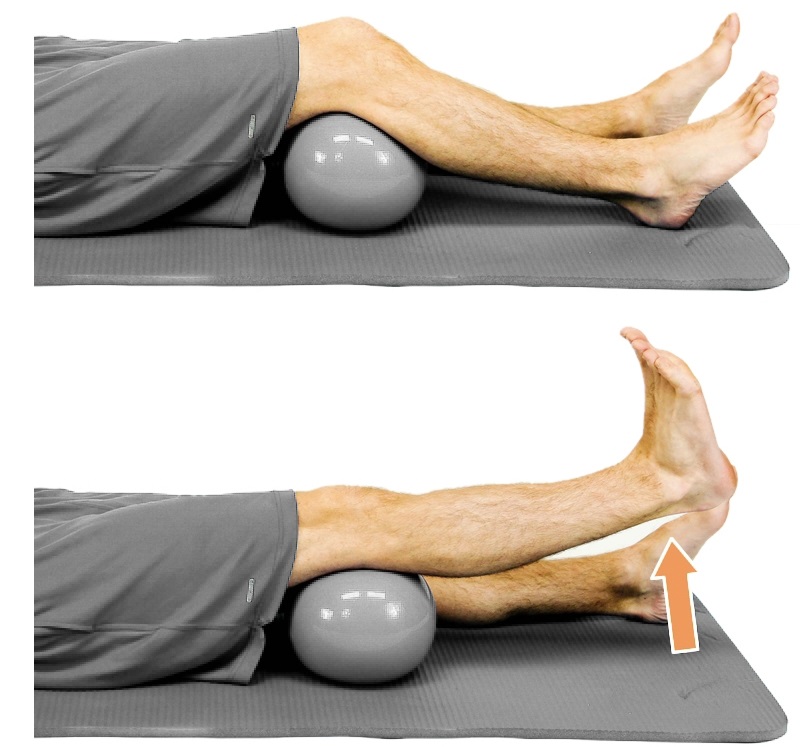
- Lie on your back with a rolled up towel underneath your knees and place the ball between your knees
- Clench your buttocks and gently squeeze the ball, then lift one heel off the ground until the knee is straight
- Keep clenching the ball and hold for 3 seconds then slowly lower the foot back down
- Repeat 10 times, gradually increasing the number of reps as you get stronger, aiming to get up to 25
3. Twisted Leg Raise
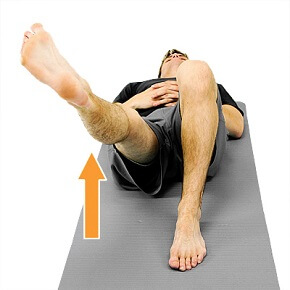
- Lie on your back with one leg stretched out straight and the other knee bent. This takes the tension off the lower back as you work the straight leg
- Turn your foot outwards about 20o into external rotation then lift the foot up until your thighs are parallel
- Hold for 3 seconds and slowly lower down, keeping the foot turned outwards
- Keeping the leg turned outwards in this vastus medialis exercise again helps to activate the VMO
4. Ball Bridges
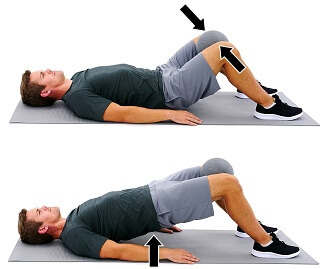
- Lie on your back with your knees bent, feet hip distance apart and the ball between your knees
- Clench your glutes, gently squash the ball and lift your bottom up as high as you can without arching your back
- Hold for 3 seconds and slowly lower down
- Keep squashing the ball and clenching your glutes throughout
- You can make the exercise harder by looping a resistance band over your hands that you anchor down with your hand
5. Ball Wall Squats
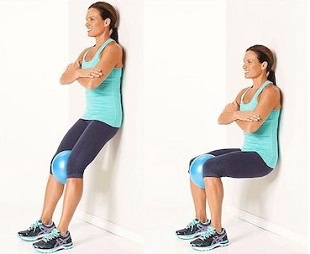
- Stand with back against a wall, squashy ball between your knees, heels about 6" away from the wall, toes pointing forwards
- Clench your glutes and gently squash the ball to activate vastus medialis oblique, then slowly slide down the wall, bending your knees
- Slide down as far as you feel in control, hold for 3 seconds and slowly push yourself back up
- Keep your glutes and the ball clenched throughout
6. Vastus Medialis Stretch
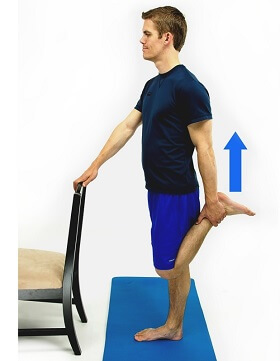
- Stand holding a chair or the wall for balance
- Bring your heel up behind you, grasp your ankle and pull your heel towards your buttock, until you feel a stretch, without bending forwards
- This will stretch all 4 of the quads muscles but you can bias the stretch towards the vastus medialis muscle by moving your foot across your body towards the other buttock
- Increase the stretch by pushing your hips forwards as you do the exercise
Hold for 30 seconds and repeat 3 times. Don’t bounce on and off the stretch, it’s much more effective to hold the stretch. For more top tips on stretching, visit the knee stretches section
Advanced Vastus Medialis Exercises
Once you can do 30 reps of each of these vastus medialis exercises with good control and are feeling confident that you are activating your VMO, you can progress onto more advanced exercises such as lunges, step ups and step downs without needing the ball.
What Else Can Help
Vastus medialis exercises are a great way to improve knee strength, stability and endurance and can really help to reduce knee pain.
To be most effective, they should also be combined with strengthening and stretching exercises for the other knee muscles:
You may also be interested in the following articles:
- Front Knee Pain
- Pain Behind The Knee
- Knee Pain At Night
- Knee Pain On Stairs
- Knee Stiffness
- Knee Pain Squatting
- Knee Pain Running
- Swollen Knee Treatment
Check Out Our New Book!
We are really excited to announce the launch of our latest book, Beat Knee Pain: Take Back Control. Everything you need to know to help you work out what is wrong with your knee and how to get back to doing what you love. Average user rating 4.5/5 on Amazon and Goodreads.
Related Articles
References
1. Journal of Orthopedic Research: Improving vastus medialis obliquus function reduces pressure applied to lateral patellofemoral cartilage. Elias JJ, Kilambi S, Goerke DR, Cosgarea AJ. 2009;27(5):578–583. doi:10.1002/jor.20791
2. Healthline: Vastus Medialis Origin, Function & Anatomy
Image use approved by hep2go.com
Page Last Updated: 12/06/24
Next Review Due: 12/06/26
